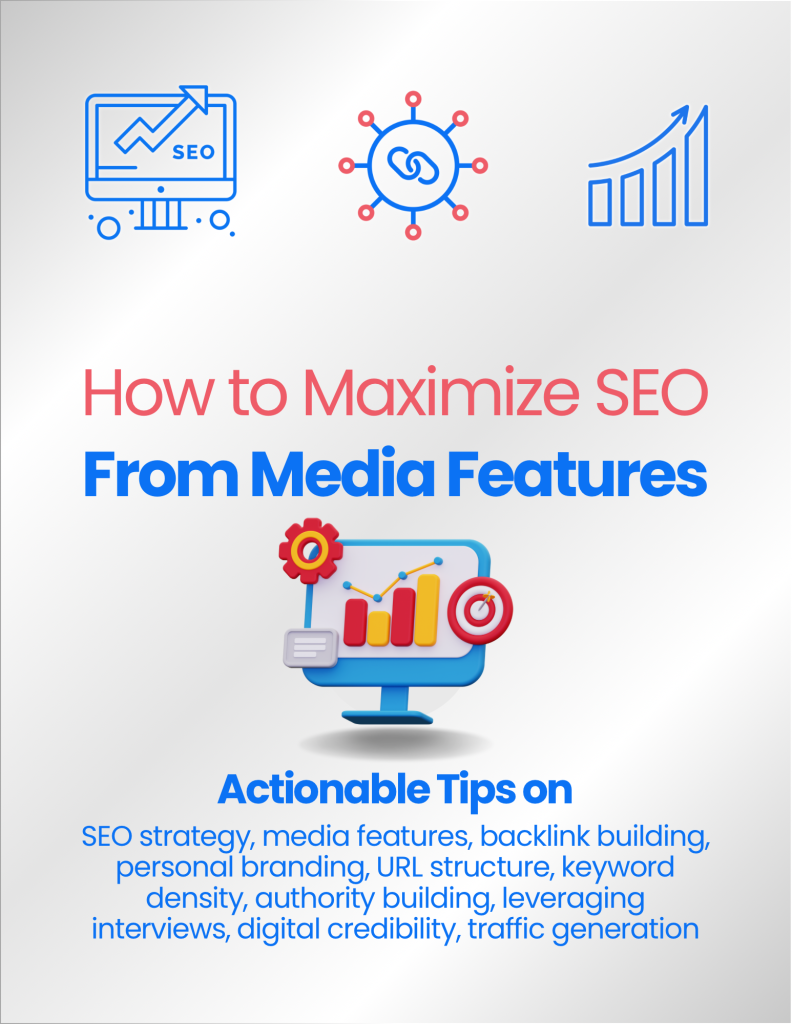Being featured on a respected publication, podcast, or TV show is a big win. But if you only post a quick link or a logo on your website, you’re missing the real opportunity—you need to maximize SEO from media features.
What Is SEO and Why Does It Matter?
SEO stands for Search Engine Optimization. It’s the process of improving your website so that it ranks higher in search engines like Google when people search for terms related to your brand, products, or expertise.
When done right, SEO helps more people discover you organically—without paying for ads. That means more traffic, more leads, and more opportunities! Let’s go over some tips to boost SEO from media exposure, like podcast episodes, magazine articles, TV or radio interviews, or blog articles about you.
Why SEO Matters:
- Visibility: If you’re not showing up on the first page of search results, most people won’t find you.
- Credibility: People trust websites that rank high on Google more than those buried on page two or three.
- Traffic: SEO drives qualified, targeted traffic from people who are already searching for what you offer.
- Leads & Sales: Higher rankings usually lead to more conversions—visitors becoming customers.
- Link Building: Earning links from trusted websites increases your authority and improves your search position.
- Compounding Value: Unlike ads that stop working when your budget runs out, good SEO keeps paying off long-term.
Every time you’re featured on a credible site and create SEO-rich content around it, you build authority, attract links, and increase your visibility. This is why strategies like the one in this article are so powerful—they don’t just celebrate a feature, they maximize SEO from media features for lasting impact.
Let’s use https://SuccessMotivationInspiration.com/ as an example. This is a high-authority media outlet that interviews successful entrepreneurs, authors, and experts. Getting featured there can boost your credibility—but only if you leverage it correctly on your own site.
How to Maximize SEO From Media Features – What Most People Do Wrong
It’s common to see “As Seen On” sections with logos of sites you’ve been featured on. Sometimes they link out. Sometimes they don’t. Either way, these logos often sit on the homepage without context, keyword optimization, or backlink structure. That’s not helping you maximize SEO from media features.
Others just paste the article link onto social media or create a blog post with nothing but, “I was featured! Check it out.” – That’s not enough!
The Better Strategy
Create a fully optimized landing page or blog post on your website for every site that features you.
Instead of just linking to the external article, create a post on your own site about the publication and what they said about you. Write an original, 800–2,500 word article that gives context, adds value, and links to your feature. This is how you maximize SEO from media features.
Why This Strategy Works
- It adds fresh, keyword-rich content to your site.
- It increases dwell time and engagement on your site.
- It provides Google with structured, relevant information.
- It strengthens your backlink profile in a natural way.
Start With a Clean URL
Keep your URL slug short and relevant.
Example:
URL: https://YourSite.com/SuccessMotivationInspiration/
Title: Your Name, Featured on the Success, Motivation & Inspiration TV Series
Don’t Copy Their Content
Copying and pasting content from the publication’s website is a big mistake. Here’s why:
- Duplicate Content Penalty: Google may ignore or penalize pages with content copied from another source. Your page may not get indexed or ranked.
- Plagiarism: You don’t own the rights to content written by someone else. Republishing it can damage relationships and credibility.
- Lost SEO Potential: If you copy their content, you’re not creating anything new for Google to index or rank. It won’t help you maximize SEO from media features.
Solution: Write your own article about the feature. Summarize the experience. Pull quotes. Give context. Explain what was discussed and why it matters to your audience.
Include the Right Elements
- Headline: Include your name and the name of the platform that featured you.
- Intro paragraph: Share why this feature is meaningful and relevant to your audience.
- Body:
- Summarize what the publication or show is about
- Highlight key topics you discussed
- Include a few quotes or screenshots
- Embed media like a YouTube video or podcast player if available
- Link back: Always link to the original episode or article using a clean anchor text like “Watch the full interview on Success, Motivation & Inspiration.”
- Logo: Include the publication’s logo and link it to your article, not directly to their site. From your article, link to the episode or article.
- CTA: Tell readers what to do next—watch your interview, book you as a speaker, learn more about your services.
Optimize for SEO
SEO isn’t just about stuffing keywords. It’s about:
- Using the publication’s name naturally throughout the article
- Including related keywords like the topic you discussed, your industry, and what problem you solve
- Alt text on all images (especially the show logo and any screenshots)
- Proper heading structure (A single H1 for your title, H2 and H3 for subsections)
Boost Credibility and Rankings
This strategy does more than boost SEO. It shows visitors and search engines that you’re a credible, trusted expert.
You’re not just sharing a link—you’re documenting your media exposure, building authority, and stacking content that Google loves. That’s how you maximize SEO from media features.
Example Walkthrough
Let’s say you were on the “Success, Motivation & Inspiration” TV show. Here’s how your content might look:
Example Title:
John Smith, Featured on the Success, Motivation & Inspiration TV Series
Example URL:
https://johnsmith.com/SuccessMotivationInspiration/
Body Example:
I was recently honored to be interviewed on the Success, Motivation & Inspiration TV series, where I shared my journey as a startup founder and the challenges I faced while scaling my business. Hosted by M. Curtis McCoy, the show features top entrepreneurs, authors, and thought leaders who are making a positive impact in the world.
During the interview, we discussed my core business strategy, how I built a team, and the lessons I learned from failure. Curtis asked powerful questions that helped bring out some of my most important takeaways—insights I haven’t shared elsewhere.
Watch the full interview here: https://SuccessMotivationInspiration.com/John-Smith
To learn more about the TV series, visit SuccessMotivationInspiration.com
How to Ask for a Backlink to Maximize SEO From Media Features
Before you ask for a backlink, make sure you’ve earned it. The biggest mistake people make is requesting a backlink from a site they haven’t linked to or acknowledged in return. That’s a slap in the face to the site owner who gave you valuable exposure.
Here’s what to do before you ever ask:
- Create a dedicated article on your website about being featured.
- Link to the feature using SEO-friendly anchor text.
- Include their logo with proper attribution and alt text.
- Promote the article on social media and tag the publication or show.
- Send them traffic and show appreciation in a public and professional way.
Once you’ve demonstrated that you value the feature, you can reach out and say something like:
“Hey [Name], I wrote an article about being featured on your site and shared it with my audience here:
https://YourSite.com/SuccessMotivationInspiration/. If there’s ever a spot where it makes sense to link back to this, I’d be grateful. Either way, thank you again for the opportunity—your audience is amazing.”
This approach is respectful, shows you’ve already done your part, and doesn’t demand anything. It simply opens the door for a reciprocal backlink. And when done right, it often leads to one! When done naturally, link building should benefit both you and the site that features you, as well as providing additional value to the reader!
Turn Every Feature Into a Content Hub to Maximize SEO From Media Features
If you’ve been featured multiple times, create a section (category) on your website like:
https://YourSite.com/media/ or https://YourSite.com/featured/
Then, link to each individual article you’ve written about those features. Each one becomes a content hub that helps you maximize SEO from media features and boosts your domain authority.
Tips to Maximize Exposure
- Share your article link on social media—not just the external interview.
- Repurpose your article into a LinkedIn post, Instagram carousel, YouTube video, or email newsletter.
- Interlink related posts on your site to increase internal link strength.
- Track performance using Google Analytics and Search Console.
- Encourage others to link to your landing page instead of directly to the interview.
Example in Action
If your competitor hasn’t learned how to maximize SEO from media features, they might be doing podcast interviews or getting featured in magazines—but never linking to those features or creating pages about them.
You, on the other hand, understand how to maximize SEO from media features. You create an SEO-friendly landing page for every site that features you.
At first, you’ll spend more time and effort writing about each feature. But over time, you’ll gain valuable backlinks and build authority that competitors can’t catch up to.
Final Thoughts
Getting featured is just the beginning. How you leverage that exposure on your own site is what separates good brands from great ones.
Every feature is an opportunity to strengthen your SEO, build trust, and drive more traffic. Don’t waste it with a logo and a link. Build content around it. Own the narrative. Control the traffic. Maximize SEO from media features.
If you’ve been featured on Success, Motivation & Inspiration or any other respected site, go create that landing page today. It could be one of the highest-converting pages on your site.



